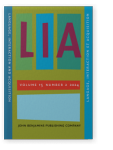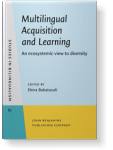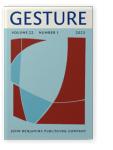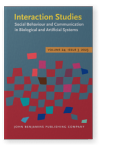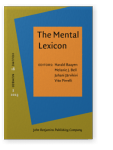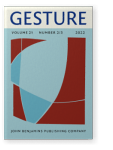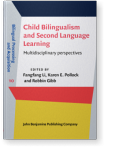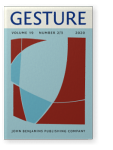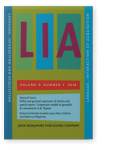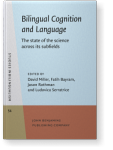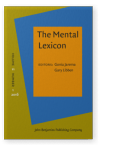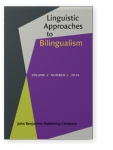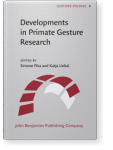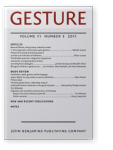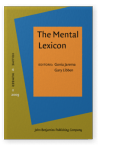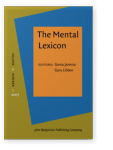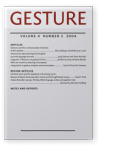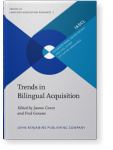Elena Nicoladis
List of John Benjamins publications for which Elena Nicoladis plays a role.
Journal
2024 Chapter 17. Bilinguals’ lexical choice in storytelling: Testing the weaker-links hypothesis Multilingual Acquisition and Learning: An ecosystemic view to diversity, Babatsouli, Elena (ed.), pp. 452–472 | Chapter
In experimental tasks, bilinguals often have greater difficulty accessing words than monolinguals and greater difficulty in their weaker language than their stronger language, consistent with the weaker-links hypothesis (Gollan et al., 2011). The purpose of the present research is to test… read more
2023 Do gestures reflect children’s lexical retrieval difficulties? Evidence from bilingual and monolingual preschoolers Gesture 22:1, pp. 94–114 | Article
According to the Lexical Retrieval Hypothesis, one important function of representational gestures is to help speakers retrieve words for production. In this study, we test whether gestures help preschoolers access words for production. We tested two predictions generated from the LRH. First,… read more
2023 Texting!!!: Attributions of gender and friendliness to texters who use exclamation marks Interaction Studies 24:3, pp. 422–436 | Article
Previous research shows that females use more exclamation marks than males, often to establish rapport. The purpose of the present studies was to test whether people associate texters’ use of exclamation marks with friendliness and femaleness. If this association is due to normative… read more
2023 Bilingual and monolingual adults’ lexical choice in storytelling: Evidence for the weaker-links hypothesis? The Mental Lexicon 18:3, pp. 401–416 | Article
Bilinguals often have a harder time accessing words for production than monolinguals, perhaps because they have less exposure to words from each language (the weaker-links hypothesis). This research on lexical access mostly comes from studies of words in isolation. The purpose of the present… read more
2022 Co-speech gestures can interfere with learning foreign language words Gesture 21:2/3, pp. 239–263 | Article
Co-speech gestures can help the learning, processing, and memory of words and concepts, particularly motoric and spatial concepts such as verbs. The purpose of the present studies was to test whether co-speech gestures support the learning of words through gist traces of movement. We asked… read more
2021 In the ear of the beholder: How ethnicity of raters affects the perception of a foreign accent Pragmatics of Accents, Planchenault, Gaëlle and Livia Poljak (eds.), pp. 229–244 | Chapter
In the present study, we tested whether a foreign accent activated different stereotypes, depending on the listener. Here, we explore whether ethnicity of a rater affects the perceived intelligence of a doctor speaking English with a Chinese accent vs. a doctor speaking English with a standard… read more
2020 Chapter 4. Two solitudes? Simultaneous bilingual children’s lexical access in experimental tasks Child Bilingualism and Second Language Learning: Multidisciplinary perspectives, Li, Fangfang, Karen E. Pollock and Robbin Gibb (eds.), pp. 45–64 | Chapter
Proficient adult bilinguals likely have one conceptual store encompassing both languages: in experimental tasks, they produce many translation equivalents. In contrast, bilingual preschoolers often produce few translation equivalents on similar tasks, perhaps because they have not yet developed… read more
2020 Out-group gestures can lower self-esteem Gesture 19:2/3, pp. 223–245 | Article
Culture-specific symbols can prime aspects of identity, like self-esteem, in bilingual-bicultural individuals. The purpose of the present studies was to test whether gestures that are specific to a culture prime self-esteem and, if so, whether it is due to in-group/out-group association. In… read more
2018 French-English bilingual children’s motion event communication shows crosslinguistic influence in speech but not gesture Verbal and gestural expression of motion and spatial events / L’expression verbale et gestuelle du mouvement et de l’espace: New evidence from different age groups and linguistic environments / nouveaux arguments en provenance de différents groupes d’âge et de différents environnements linguistiques, Fibigerová, Kateřina, Jean-Marc Colletta and Michèle Guidetti (eds.), pp. 69–100 | Article
Bilinguals sometimes show crosslinguistic influence from one language to another while speaking (or gesturing). Adult bilinguals have also shown crosslinguistic influence in gestures as well as speech, suggesting an underlying conceptualization that is similar for both languages. The primary… read more
2018 Chapter 5. Simultaneous child bilingualism Bilingual Cognition and Language: The state of the science across its subfields, Miller, David, Fatih Bayram, Jason Rothman and Ludovica Serratrice (eds.), pp. 81–102 | Chapter
Simultaneous bilingual children are exposed to two languages from an early age. They show a remarkable ability to differentiate their two languages from early in development. They nonetheless show some small signs of cross-linguistic influence, or processing their two languages in ways that show… read more
2016 Deverbal compound comprehension in preschool children The Mental Lexicon 11:1, pp. 94–114 | Article
When English-speaking children first attempt to produce deverbal compound words (like muffin maker), they often misorder the noun and the verb (e.g., make-muffin, maker muffin, or making-muffin). The purpose of the present studies was to test Usage-based and Distributional Morphology-based… read more
2012 Does ontogenetic ritualization explain early communicative gestures in human infants? Developments in Primate Gesture Research, Pika, Simone and Katja Liebal (eds.), pp. 33–54 | Article
This chapter evaluates predictions that the origins of at least some gestures of human infants are shaped through ontogenetic ritualization (Clark 1978; Lock 1978; Tomasello 2008). To do so, we examine the development of five gesture types in four children between the ages of 6.5 and 11.5 months.… read more
2011 Bilingual children’s gesture use Gesture 11:3, pp. 330–347 | Article
Previous studies have shown that bilinguals use more manual gestures than monolinguals (Pika et al., 2006; Nicoladis et al., 2009), suggesting that gestures may facilitate lexical retrieval or may reduce the cognitive load on working memory during speech production. In this study, we tested the… read more
2009 Why are Noun-Verb-er compounds so difficult for English-speaking children? The Mental Lexicon 4:2, pp. 276–301 | Article
Preschool children who attempt novel NV-er compounds (like cat brusher) often misorder the noun and the verb, arguably based on sentential phrasal ordering (e.g., Clark, Hecht, & Mulford, 1986). In this study, we test this argument by replicating Clark’s prediction that children’s attempts will… read more
2007 Acquisition of deverbal compounds by French-speaking preschoolers The Mental Lexicon 2:1, pp. 79–102 | Article
Children’s creation of novel words is thought to be guided by several variables of their language(s), including the simplicity and frequency of required morphology and/or target structure (Clark, 1993). This study documents children’s acquisition of French deverbal Verb–Object compounds (e.g.,… read more
2005 Gestures by advanced Spanish-English second-language learners Gesture 4:2, pp. 143–156 | Article
We examined the role of deictic (i.e., point) and symbolic (i.e., imagistic) gestures in advanced Spanish-English second-language learners to determine whether the role of gestures is consistent with that of intermediate second-language learners (i.e., Gullberg, 1998). Participants (10 L1 Spanish… read more
2001 Finding first words in the input: Evidence from a bilingual child Trends in Bilingual Acquisition, Cenoz, Jasone and Fred Genesee (eds.), pp. 131–147 | Article
